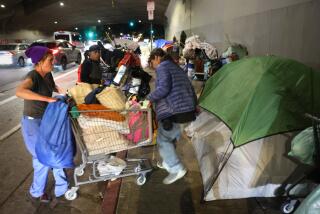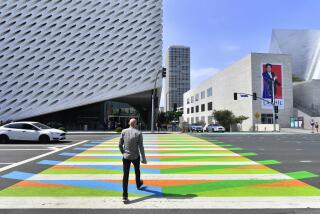L.A. trying to lift legal snag on $7.5 million for art projects

Los Angeles officials are starting to get serious about freeing up $7.5 million in city government funds that are earmarked for visual art, performances or other cultural events, but have been wrapped tightly for years in legal red tape.
The amount – which is almost on a par with the Department of Cultural Affairs’ $9 million annual core budget – was rendered virtually unspendable in 2007 when then-City Attorney Rocky Delgadillo ruled that the fees developers are required to pay to fund public art had to be spent within a one-block radius of the construction project that generated the fees.
Since it doesn’t make sense to install artworks or put on cultural events in every block where a building has been newly built or renovated -- in a warehouse district or industrial corridor, for example – the Cultural Affairs Department has sat on the money while hoping to get the 2007 ruling changed.
CRITICS’ PICKS: What to watch, where to go, what to eat
City Controller Ron Galperin pushed the effort forward Friday, issuing an audit report on the public art program that quantified the lack of spending and recommended relaxing the one-block-radius requirement.
In compiling the report, the auditors said, they consulted with the staff of current City Attorney Mike Feuer, who saw “more flexibility” than what the 2007 ruling that’s still in effect has allowed.
The City Council also has been on the case, albeit moving slowly. Between last May and November, it considered and passed a motion calling on the city attorney and a bevy of departments involved in overseeing construction projects to look into a possible overhaul of the city’s public art ordinance.
The council asked not just for consideration of the geographical jam, but also requested a report, not yet delivered, on whether it would make sense to increase the fees developers are required to pay. They vary depending on the kind of building involved, but are targeted at about 1% of a project’s design and construction costs.
The City Controller’s audit did not fault the Cultural Affairs Department for failing to spend the $7.5 million in geographically frozen fees from 373 different development projects (made up of $6.4 million in developers’ payments, plus $1.1 million in interest earnings). But it noted that the department may have hurt its own cause by failing to make required reports to the City Council that would have shown that public art funds were languishing unspent.
PHOTOS: The most fascinating arts stories of 2013
“Formally submitting the required quarterly and annual reports of activities could have resulted in the city taking action to address this issue,” the audit said. Instead, the report said, the problem appeared on the City Council’s radar last May when the unspent public art money became an issue during a discussion of the Cultural Affairs Department’s budget -- which is now 38.4% lower than in 2004, adjusting for inflation.
Over the last 26 years, the developer fees have generated $92.6 million, including $26 million in public money from the city charging itself fees for government-funded construction. When it’s spent, the money directly benefits visual artists and performers contracted to create the art, and, presumably, citizens who get to experience it.
Developers can opt to design and oversee the art projects they’re funding, subject to the Cultural Affairs Department’s approval. The audit found that those kinds of projects went forward without major delays.
But in many cases developers decide to just fork over the money and let the Cultural Affairs Department hire artists or plan performances and events to satisfy the public art requirement. The audit said that the department had used the money for programs throughout the city until the 2007 legal ruling put it in a geographical straitjacket. Checking with five other California cities, auditors said they found their public art spending was not bound by such a “narrow geographic radius” as in L.A.
GRAPHIC: Faces to watch 2014 | Entertainment
The audit’s release coincided with “Arts Day L.A.” on Friday at City Hall, in which the advocacy group Arts for L.A. brought about 400 people to the City Council meeting and for smaller gatherings with each of the 15 council members to urge improvements in the city’s approach to the arts.
Danielle Brazell, Arts for L.A.’s executive director, said that along with pushing for specific actions, including freeing up the frozen public art fees, the idea was to “change the conversation” about arts and culture at City Hall, so that council members and other officials recognize “the value of arts and culture in our daily lives in Los Angeles. From there, I think the resources will flow.”
Mayor Eric Garcetti will reveal his own ideas about arts spending later this month, when his first budget proposal since taking office is due. He’s also mulling whom to hire as a new head of the Cultural Affairs Department. Olga Garay-English, who’d been appointed by former Mayor Antonio Villaraigosa, left in January after Garcetti decided not to rehire her.
RELATED:
Garcetti meets arts leaders to brainstorm, urge fresh thinking
Mayor won’t rehire L.A. cultural affairs head Olga Garay-English
More to Read
The biggest entertainment stories
Get our big stories about Hollywood, film, television, music, arts, culture and more right in your inbox as soon as they publish.
You may occasionally receive promotional content from the Los Angeles Times.







